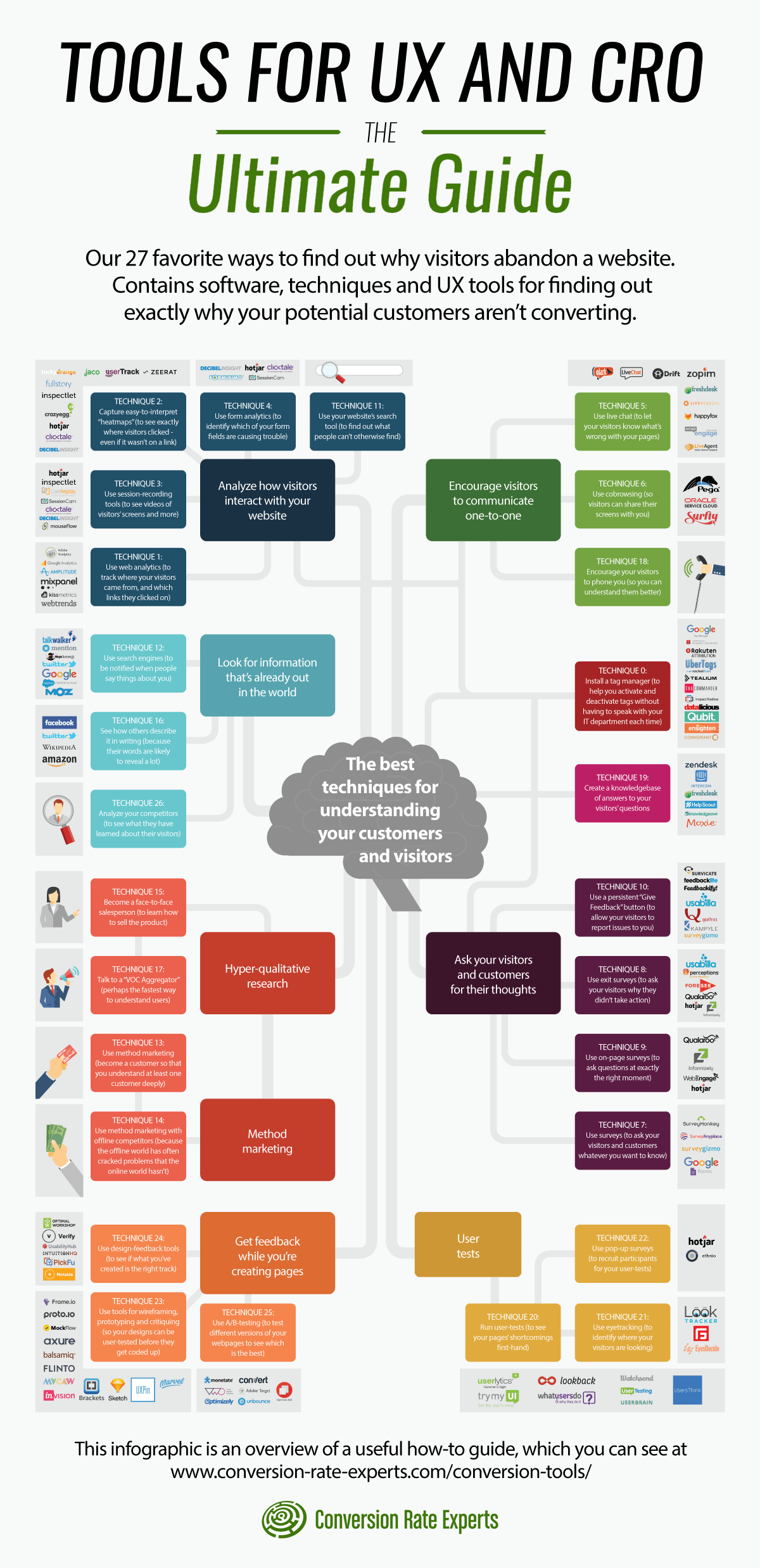Tools for UX and CRO: The Ultimate Guide
(By the way, to get articles like this free in your inbox, subscribe to our newsletter.)
View an enlarged version of this infographic.
Download a high-resolution PDF version of this infographic.
…and then scroll down to read the accompanying ridiculously useful series of articles.
Do you want to add this infographic to your site?
The ultimate guide to understanding your customers and visitors
This is the first in a series of articles in which we reveal our 27 favorite ways to find out why visitors aren’t converting.
It’s pure gold.
It includes 208 resources—software, techniques and UX tools for finding out exactly why your potential customers aren’t converting.
In 2008, we published the most comprehensive article about how to understand your website’s visitors. Back then, there were hardly any tools for doing it: our list contained just fourteen. This, eight years later, is the first major update. As evidence of how much the web has changed since then, this version contains 208 resources.
Why this series of articles will allow you to out-perform most marketers

Imagine you had to buy lunch for a group of people. But you had no idea what kind of food they liked.
You might decide to buy them whatever’s popular: “Most people like burgers,” you might think. “I’ll buy them burgers.”
Your success rate with that strategy would be okay. But how could you improve upon it? Buy better burgers? No, to get a breakthrough improvement, you’d need to get to know the people. In doing so, you might discover that one of them is vegan, that another loves pizza, and that another loves burgers but prefers salads at lunchtime. With a modest effort, you could greatly improve upon the burger strategy.
In the lower leagues of marketing, the burger strategy works okay. A local company can achieve some level of success by throwing in a guarantee, some testimonials and an urgent call to action. But things are much harder for a successful web business. A successful web business needs to understand its customers better than its competitors do.
So what do you need to know about your visitors? At the very least, you need to understand why most of them leave without buying.
Unfortunately, those non-converting visitors come and go without a trace. How can you find out what they wanted? How do you know what would have persuaded them to take action?
If you owned a real-life bricks-and-mortar store, this would be easy: You’d hear their objections. You’d be able to ask questions. You’d hear what they muttered as they headed for the door.
Capturing the voice of the customer is more difficult on the web, but it can be done. It’s what our Research Department does every day. Over the past ten years, we have carried out research into the visitors of companies in 80+ different verticals, in 11 languages, and in 40 countries. We have carried out thousands of experiments, measurably grown hundreds of businesses, and generated billions in revenue.
We often use the tools our clients are already using, so we have a lot of experience in what’s out there. This series of articles describes the tools and techniques that we have found to be the most useful, the ones that generate the most “insights per minute.” Each provides insight into a different aspect of your visitors’ behavior—including what the visitors want, what they like, how they make decisions, and what they don’t like. Together, the tools create a clear picture of how you can improve your website’s performance and profits.
Several notes about this series of articles
- We don’t get paid for mentioning or recommending any of the tools.
- We mention Moz, Google, Kissmetrics and Crazy Egg, all of which have been clients of ours. In all cases, we were using and recommending them before they became clients.
- It used to be that each software solution carried out a specific function. Now, they all tend to be progressing in the direction of becoming all-purpose suites, making them hard to categorize. We have grouped each software solution into the functionality for which we most often use it.
- Mobile web usage has skyrocketed, but the tools for understanding visitors have been slow to catch up. It’s finally happening, though. Throughout this series, we will label some of the tools as being “mobile-friendly.” That doesn’t mean that the others aren’t; it just means that either the tool has been specifically built for mobile, or that we have experience using the tool on mobile devices, and it works well.
Index of the techniques in this series
- Technique 0 (described below): Installing a tag manager (to help you activate and deactivate tags without having to speak with your IT department each time).
- Technique 1: Using web analytics (to track where your visitors came from, and which links they clicked on).
- Technique 2: Capturing easy-to-interpret click-maps (to see exactly where visitors clicked—even if it wasn’t on a link).
- Technique 3: Using session-recording tools (to see videos of visitors’ screens and more).
- Technique 4: Using form-analytics software (to identify which of your form fields are causing trouble).
- Technique 5: Using live chat (to let your visitors tell you what’s wrong with your pages).
- Technique 6: Using cobrowsing (so your visitors can share their screens with you).
- Technique 7: Using survey tools (to ask your visitors and customers whatever you want to know).
- Technique 8: Using exit survey tools (to ask your visitors why they didn’t take action).
- Technique 9: Using on-page survey tools (to ask questions at exactly the right moment).
- Technique 10: Using a persistent “Give Feedback” button (to allow your visitors to report issues to you).
- Technique 11: Using your website’s search tool (to discover what your visitors can’t otherwise find).
- Technique 12: Using search engines (to be notified when people say things about you).
- Technique 13: Using method marketing (become a customer so that you understand at least one customer deeply).
- Technique 14: Using method marketing with offline competitors (because the offline world has often cracked problems that the online world hasn’t).
- Technique 15: Becoming a face-to-face salesperson (to learn how to sell the product).
- Technique 16: Seeing how others describe it in writing (because their words are likely to reveal a lot).
- Technique 17: Talking to a “VOC Aggregator” (perhaps the fastest way to understand users).
- Technique 18: Encouraging your visitors to phone you (so you can understand them better).
- Technique 19: Creating a knowledgebase of answers to your visitors’ questions.
- Technique 20: Running user-tests (to see your pages’ shortcomings first-hand).
- Technique 21: Using eye tracking (to identify where your visitors are looking).
- Technique 22: Using pop-up surveys (to recruit participants for your user-tests).
- Technique 23: Using tools for wireframing and prototyping (so your designs can be tested before they get coded up).
- Technique 24: Using design-feedback tools (to see if what you’ve created is on the right track).
- Technique 25: Using A/B-testing (to test different versions of your webpages to see which is the best).
- Technique 26: Analyzing your competitors (to see what they have learned about their visitors).
- Bonus Technique: Conversion for low-traffic websites, (revealing which of the above techniques work best when you don’t have many visitors.)
Technique 0: Installing a tag manager (to help you activate and deactivate tags without having to speak with your IT department each time)
This series of articles will no doubt persuade you to install multiple tools on your website. You may get tired of asking your developers to activate, manage and deactivate tags. So before we continue, you may benefit from installing a tag-management solution like Google Tag Manager. Tag-management solutions provide marketers with an easy-to-use interface that doesn’t require the user to have IT skills or IT permissions.
Alternatives to Google Tag Manager include Adobe Activation Core Service, Ensighten, IBM Digital Data Exchange, Tag Manager by ImpactRadius, TagCommander, and Tealium iQ.
Read the next article in this series
This article is the first in a series. The next part is here.
How much did you like this article?
© 2025 Conversion Rate Experts Limited. All rights reserved.
















